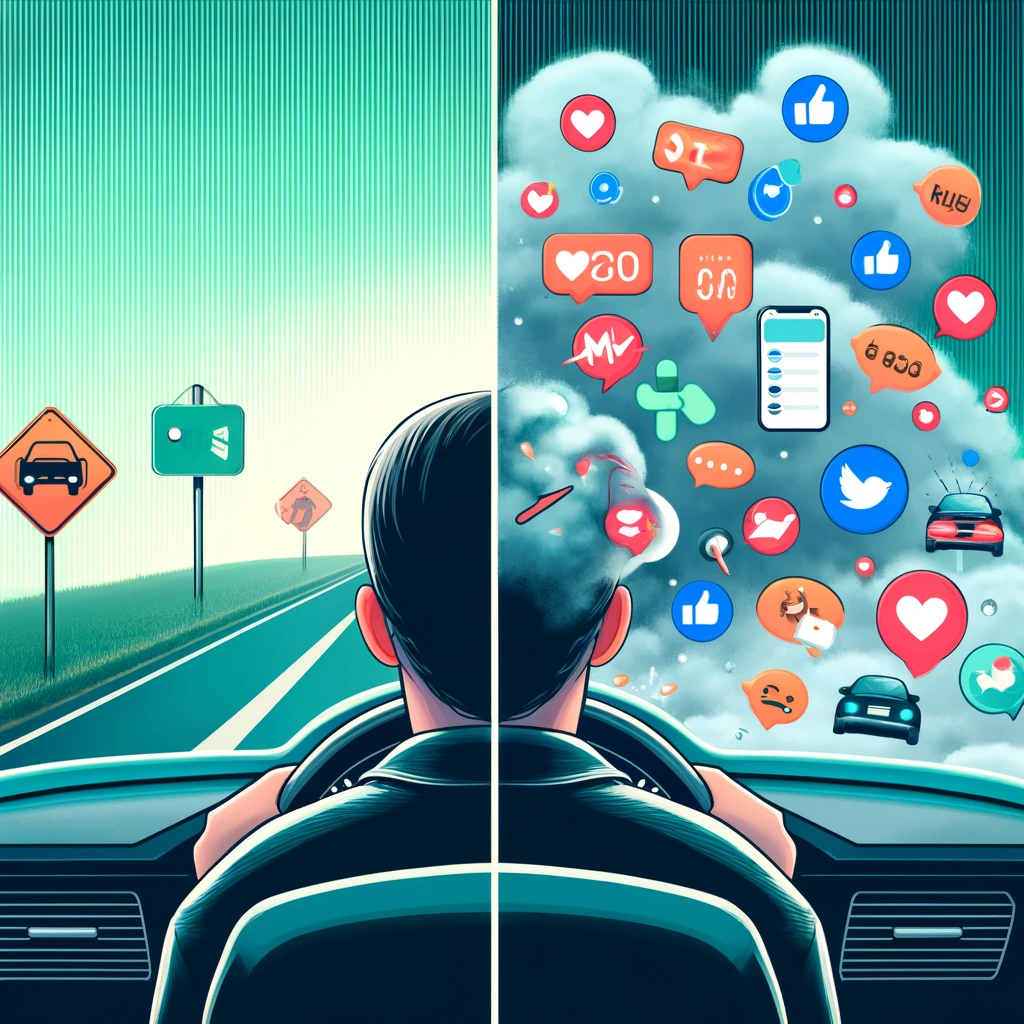by Todd Cooper
When teaching clients, I’ve consistently observed a challenge—many place more importance on maintaining social interactions than on the essential task at hand: driving. This becomes especially apparent when clients try to hold conversations while driving, a behavior that imposes an unnecessary cognitive load. Research has shown that this split attention can be detrimental to driving performance, leading to delayed reaction times, missed hazards, and poor decision-making on the road.
In a study conducted by the National Highway Traffic Safety Administration (NHTSA), it was found that “drivers engaged in conversation showed a marked decrease in situational awareness and were slower to react to external stimuli, such as changes in traffic flow or the sudden appearance of obstacles” (NHTSA, 2020). The cognitive load required to maintain a conversation pulls attention away from driving, which is already a mentally demanding task.
This is why I’ve implemented periods of complete silence during lessons. A simple, uninterrupted 15 minutes of silence allows my clients to fully immerse themselves in the driving experience, feeling the car’s movements and scanning their environment without the distraction of conversation. Neuroscientific research on cognitive load supports this approach, showing that multitasking, especially during high-stakes activities like driving, significantly decreases performance. Dr. David Strayer, a cognitive neuroscientist specializing in driver distraction, states, “The human brain is not wired to multitask efficiently. When driving, tasks like talking or texting reduce the brain’s ability to process visual information by as much as 37%” (Strayer, 2011).
A recurring example of this misalignment of priorities can be seen when clients are preparing for a lane change. It’s common for them to say things like, “Oh, I hope that driver back there lets me in” or “The guy in the target lane isn’t letting me in.” This thinking is a clear indication that they are treating the lane change as a social interaction rather than a procedural task of safely merging based on speed and space. Research by the Traffic Injury Research Foundation (TIRF) highlights this tendency, noting that “drivers who prioritize social norms in traffic situations are more likely to delay critical decisions, such as lane changes, due to the perception that they need approval or cooperation from other drivers” (TIRF, 2017). However, lane changes are not social transactions—they must be executed based on clear assessments of distance, speed, and available space, independent of the actions of other drivers.
Moreover, making a lane change demands high levels of visual and cognitive processing. Studies from the University of Michigan’s Transportation Research Institute found that “executing a safe lane change requires drivers to process up to 15 different pieces of visual information within a span of just a few seconds” (UMTRI, 2018). These pieces of information include assessing the speed and distance of vehicles in front, behind, and beside the driver, as well as monitoring blind spots and maintaining control of their own vehicle. This complex process requires multiple rapid visual assessments, or ‘saccades,’ to measure speed changes in surrounding vehicles.
In my own experience, an experienced driver will naturally take these 15 or more glances in rapid succession before committing to a lane change. A new driver, however, may struggle with reading the mirrors and blind spots effectively, sometimes turning their head to confirm what they’ve seen in the mirror. This adds to the cognitive load and makes the task more difficult when divided attention—such as engaging in conversation—further weakens their processing ability. Neuroscientific studies by Marc Green on visual processing in driving have shown that “efficient driving requires continuous updating of the mental model of traffic, which is impaired when the brain is overloaded with non-driving tasks” (Green, 2003).
The solution is simple but profound—silence. Silence removes the cognitive burden of conversation and allows drivers to focus fully on the task of driving. Clients who experience this silent period begin to understand that their primary responsibility is to interact with the road and the surrounding environment, not to maintain social exchanges.
Source Materials: In-Depth Examination of Findings
- NHTSA Study on Cognitive Load and Driving (2020):
In a comprehensive study, the National Highway Traffic Safety Administration found that drivers engaged in conversations—whether via mobile phones or with passengers—showed slower reaction times and reduced situational awareness. This was attributed to the brain’s inability to process both verbal and visual information simultaneously at high levels of efficiency. “When engaged in conversation, drivers were 24% slower to respond to changes in traffic flow and were more likely to miss visual cues, such as brake lights or traffic signals.” - Dr. David Strayer’s Research on Multitasking and Driving (2011):
Dr. Strayer’s work has been pivotal in demonstrating the effects of cognitive distraction on driving. His research, conducted at the University of Utah, used functional magnetic resonance imaging (fMRI) to observe the brain activity of drivers engaged in various tasks. His findings revealed that “talking while driving reduces brain activity associated with driving by 37%, particularly in areas of the brain responsible for visual processing and decision-making” (Strayer, 2011). This data underscores the importance of minimizing distractions to improve driving performance. - TIRF Report on Social Norms in Traffic Behavior (2017):
A report from the Traffic Injury Research Foundation explored how drivers’ perceptions of social norms affect their behavior on the road. According to the report, “drivers who perceive lane changes or merging as dependent on the ‘permission’ of other drivers are more likely to delay critical decisions, leading to sudden, last-minute maneuvers that increase the risk of collisions” (TIRF, 2017). The study advocates for better education on the independent, legal requirements of lane changing to improve safety. - UMTRI Study on Visual Processing in Lane Changes (2018):
The University of Michigan Transportation Research Institute conducted a detailed analysis of the visual demands of lane changes. Their findings showed that “executing a safe lane change requires the driver to process up to 15 discrete visual cues within a span of 5-7 seconds. These cues include checking mirrors, blind spots, and vehicle speeds in adjacent lanes, as well as monitoring one’s own speed” (UMTRI, 2018). The study highlighted that even minor distractions could severely impair the ability to safely complete a lane change. - Marc Green’s Research on Visual Processing in Driving (2003):
Marc Green, a researcher in human factors psychology, explored the impact of visual overload on driving performance. He found that “the brain’s ability to process and respond to visual stimuli in driving situations is compromised when it is overloaded with tasks such as conversation or in-vehicle distractions” (Green, 2003). His work supports the argument that driving performance is improved when cognitive distractions are minimized.
By referencing these studies, the argument for silence during driving lessons is not only reinforced but deeply grounded in traffic research and cognitive neuroscience. These findings underscore the idea that conversation and social connection are cognitive distractions that can diminish the ability to safely and effectively operate a vehicle.
End Note from the Author: Transport Canada Cell Phone Studies – Todd Cooper, Senior Assessor
As the senior assessor during these applied research studies in downtown Ottawa traffic, I saw the effects firsthand of drivers talking with PhDs sitting in the backseat, talking to PhDs at the other end of a cell phone, and driving without any conversation. My role was to let the driver behave naturally under each of these conditions so we could assess their performance. My primary responsibility, however, was to ensure that they didn’t crash the vehicle, despite their distractions. I used a six-number scoring scale to measure six crash-related factors every 20 to 30 seconds during a 60-minute drive, all while protecting the driver, the PhDs, and the public.
In one instance, a driver, completely distracted by conversation, drove straight through a red light in rush hour traffic, unaware of the danger. The skills I developed over decades allowed me to manage these dangerous situations safely while collecting valuable data on the effects of cognitive distraction while driving. And yes, we made it through unbeknownst to the driver.
© 2024 Todd Cooper – Quality Driving Lessons. All materials are copyright-protected. DOWNTOWN VANCOUVER BRITISH COLUMBIA CANADA




Comments are closed